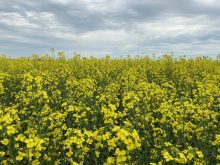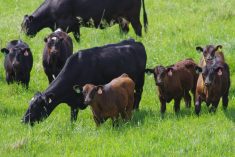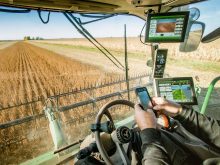Reuters / French start-up company Ynsect has identified a cheap, nourishing and locally sourced alternative to soybeans as a vital source of protein in animal feed. The clue is in its name.
Ynsect is not alone in looking to invertebrates to meet a jump in demand for meat and fish, and so for feed, in coming decades.
Black soldier flies, common housefly larvae, silkworms and yellow mealworms were named as among the most promising species for industrial feed output in a report last month by the FAO, the United Nations food agency.
Read Also

An unbelievable tale of a lost engagement ring
After nearly 50 years, a southern Alberta farmer finds her wedding ring in an unusual place.
“Given insects’ natural role as food for a number of farmed livestock species, it is worth reconsidering their role as feed for specific poultry and fish species,” the Food and Agriculture Organization’s report said.
Jean-Gabriel Levon, co-founder of Ynsect, said new protein sources were essential in a market where costs are set to climb.
“Insects are an interesting source which can be bred locally,” Levon said. “We are in the same situation as oil, with resources getting scarcer and more expensive.”
According to the FAO, protein such as meat meal, fishmeal and soymeal make up 60 to 70 per cent of the price of feed.
Soybean prices have more than doubled over the past decade due to soaring demand and fishmeal prices have also jumped.
The two-year old company has been developing an insect-based meal that could make up five to 30 per cent of feed products, Levon said.
Ynsect, which has around 10 rivals globally, is now raising funds to build the first European insect meal production unit by 2014-2015. One well-heated part of the plant would breed insects and the other would crush them into powder.
It aims to focus on using flies and beetles and Levon says a great advantage is that they can eat just about anything — for example human food leftovers such as potato peelings.
Great fertilizer
What is more, insect droppings make great fertilizer.
“Insects drink very little water. Their droppings are very dry. They’re like sand and have all the qualities needed for a classic fertilizers,” Levon said.
Stephane Radet, who heads France’s animal feed industry lobby (SNIA) said he was cautious as the protein product would have to prove itself to feed makers and win public acceptance.
“For new material to enter the manufacturing chain, it has to meet four major criteria: safety, quality, competitiveness and acceptability in the food sector, processors and at the bottom of the chain, the consumer,” Radet said.
While another pioneering company, South Africa’s AgriProtein Technologies, is rearing house flies and using insect flour for cattle feed, this is not allowed in the European Union where the “mad cow” disease crisis of the late 1990s has led to caution over the use of processed animal proteins (PAPs).
PAPs, particularly when cattle were given bovine protein, were blamed for the bovine spongiform encephalopathy (BSE) outbreak.
The European Commission has approved the use of PAPs to feed fish from June 1, which includes insect meal. It may allow their use in pig and poultry feed from 2014, lifting a ban on animal by-products imposed during the BSE outbreak.
The EU imports about 70 per cent of its protein-rich material for animal feed. According to European Feed Manufacturer’s Federation Fefac, Europe’s market for processed animal feed is worth around 45 billion euros ($60 billion) a year.
Ynsect aims to start with fish feed, where insect-based meal could replace increasingly scarce fishmeal and fishoil.
Trials on certain fish species showed that diets where up to 50 per cent of fishmeal was replaced with grass hopper meal produced equally good results as fishmeal only, the FAO added.
A further step one day might be to rear insects for direct human consumption. The FAO said insects already feed more than two billion humans in Africa, Asia and South America.














